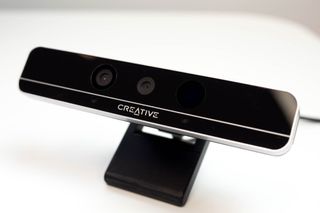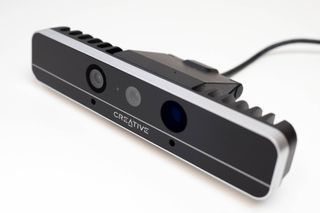Windows Hello – What's the difference between an iris scanner and 3D facial recognition?

After posting our report earlier on Microsoft's October plans a bit of confusion cropped up in comments. Why would I worry that a Windows Hello camera cannot fit into a 12-inch Surface, but it can in a phone?
The answer is simple but requires a bit of explanation. The shorter answer is there are two different technologies for Windows Hello (three, when you add in fingerprints).
Facial Recognition

Facial recognition right now is being accomplished with the Intel RealSense F200 reference camera reference design. Some laptops are already using it (see here), and more will be in the coming year. That is the camera we have demonstrated on video as a development device that you can order from Intel.
The F200 is not tiny (Note: the F200 is front-facing; R200 is world-facing). For instance, it has three cameras, not just one. Those cameras are:
- Infrared
- 3D
- Traditional RGB (aka webcam)
Moreover, the F200 is more than just facial analysis as it can also be used for hand/finger tracking, speech recognition, augmented reality, and background segmentation.
The F200 is more like a full-blown Kinect camera. It also happens to be Windows Hello ready so that you can use your face to unlock your computer. It is chunky too, which is why it is harder to jam into a small bezel display.
3D facial recognition is good because it works at a distance (0.2 – 1.2-meter range). That makes it ideal for PCs and laptops since the user is pushed back further from the display.
Get the Windows Central Newsletter
All the latest news, reviews, and guides for Windows and Xbox diehards.
Iris scanner

When it comes to the eyes, there are two methods: iris and retina scanning. Retina scanner scans the blood vessel patterns at the back of the eye and is a very reliable and foolproof system. Iris scanning just scans the patterns on the colored part of the eye in front. Iris scanning can be done with a camera. Retina scanning, well, is more complicated.
Iris scanning is what we are talking about when it comes to Windows Phone. You only need existing camera technology to make it work. There should be no "extra" hardware, unlike 3D facial recognition. Besides the camera, you usually need a light-emitting diode and a light-receiving sensor. These light up the eye usually with an invisible light (near-IR) so that the camera can scan the iris. The scanner works in low light (even dark rooms) and works with clear contact lenses, eyeglasses, and non-mirrored sunglasses.

Iris scanners are much cheaper to implement than fingerprint scanners (extra hardware) and much smaller than 3D facial recognition (two fewer cameras).
Iris scanners need to be much closer to the face to pick up the details of the iris (think arm's length, maybe a bit less). Because of its smaller size, cheaper components and ability to work close to the face, it is ideal for phones. This is why the Lumia 950 and Lumia 950 XL are going to feature this type of technology.
Sure, a 3D facial recognition camera system would be great for phones too, but the price and size of the hardware is just too massive for a mobile. Maybe someday.
Conclusions
When it comes to Windows Hello, Microsoft, and their partners have three options:
- 3D Facial Recognition
- Iris Scanning
- Fingerprint Scanning
It is also very likely that any biometric system can hook into the Windows Hello system as the technology comes online. Each one has advantages and disadvantages, including range, accuracy, costs, and size. One downside of fingerprint scanning is you cannot wear gloves with it, so it's bad in the winter, and you need your finger ideally placed. Fingerprints can also be lifted since we leave prints all around although "fooling" a scanner with them is not so easy either.
When it comes to Windows Hello, expect the larger, more robust facial recognition for PCs and the smaller, more cost efficient iris scanner for phones. Got it? Great, now go forth and spread the word!

Daniel Rubino is the Editor-in-chief of Windows Central. He is also the head reviewer, podcast co-host, and analyst. He has been covering Microsoft since 2007, when this site was called WMExperts (and later Windows Phone Central). His interests include Windows, laptops, next-gen computing, and watches. He has been reviewing laptops since 2015 and is particularly fond of 2-in-1 convertibles, ARM processors, new form factors, and thin-and-light PCs. Before all this tech stuff, he worked on a Ph.D. in linguistics, watched people sleep (for medical purposes!), and ran the projectors at movie theaters because it was fun.
